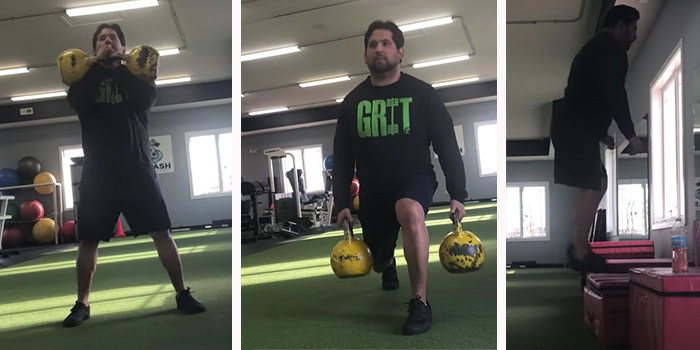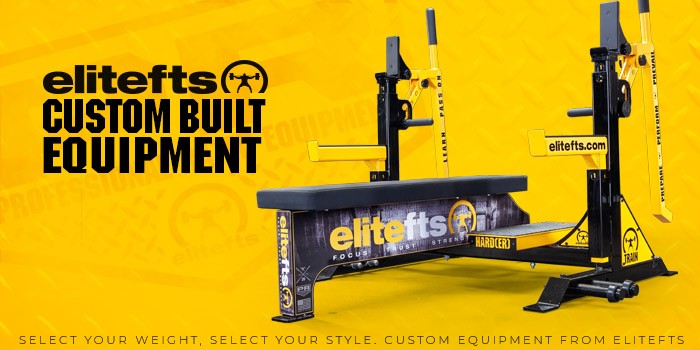
In Part 1, I covered a recent injury I suffered and the rehabilitation plan I used to recover from it. The plan included a collaborative approach with a professional and the sage wisdom of a grizzled meathead. In my opinion, true healing begins from self-motivation (a fire within) that requires a focused and well-guided plan that utilizes pragmatic modalities from the physical therapy world as well as tried and true strength training methods.
The fire within is the most necessary component to truly return play/press/etc. In a day and age where the snowflakes of the world are looking to have their hands held through everything, only you can make yourself stronger.
PART 1: Project Return to Press: No Barbell, No Problem
In Part 2, we’ll dive into the process of returning to barbell work after this specific tissue injury. More specifically the how and why of the organization of training I chose.
The end of Part 1 mentioned some goals I planned to reach before returning to the barbell. On July 29th, I hit four sets of 25 push-ups three hole spaces from the bottom of my elitefts 3x3 Power Rack, LDISO with 35s for three minutes, and easy get-ups with 26 pounds.
Fast forward to August 12, and I checked the box with four sets of 25 push-ups from the floor, five sets of get-ups with 44 pounds, and hit 3.5 minutes with 50-pound dumbbells. I know this is short of the five minutes, but after three tries, I seemed to hit a level of diminishing returns, especially trying this every day. I not only felt confident in my tissue health but was itching to get back to pressing.
The Plan
Given I’m a clean slate at this point, I figured it would be wise to use a bit of a different approach with a similar layout. Before the injury, I used a version of the conjugate system with max effort (more like heavier lower/upper body days) and dynamic effort days that rotated exercises for heavy lower/upper for every four-week block. Here I would train a front squat variation (SS Yoke Bar or barbell) for three weeks and a deadlift on the fourth week before moving on to a box squat variation that utilized different bars.
The dynamic effort days rotated similarly via bars or accommodating resistance using the isodynamic belt squat for the fourth week. I ran these on a nine-day week as I used to in the last four years of my competitive days from 2009 to 2012. As Swede Burns has mentioned in his 5thSet system, this layout allows for better recovery and super-compensation to be realized, I couldn’t agree more.
For my return, I’m keeping the layout of the nine-day training week the same but am employing versions of 5/3/1 — most notably, the 5x5/3/1-5 second progression on heavy lower/upper days {1, pg 67}. Given I’m coming off a barbell layoff of two months (yes, I even waned off the barbell for squats, which was tough, but I’ll go into why I actually liked that later), I’m taking Jim Wendler’s advice on conservative training max adjustments and training off of 75 percent of where I left off.
I don’t know if any 5/3/1ers have ever tried this, but instead of doing the last set for 5x5 in the five-second Pro, I simply waved the five sets. For example:
- Week 1: 65%x2x5, 75%x2x5, 85%x5
- Week 2: 70%x2x5, 80%x2x5, 90%x5
- Week 3: 75%x2x5, 85%x2x5, 95%x5
This protocol allows for getting more work going into the heaviest set of the day. I’m also tinkering with a five set-up down pyramid that goes:
- 65%x5
- 75%x5
- 85%x5
- 75%x5
- 65%x5
Same but different à la Dan John.
The dynamic effort days have turned into a version of Jim’s Boring But Strong Protocol {1, pg 134}, where ten sets of five of the first set (65/70/75 percent, respectively) are done. The elements I changed here were:
- Cutting down to 3 reps
- Using an accentuated eccentric movement with a 5-countdown
- Performing each set on the minute
My reasoning for employing these elements is to continue to drive tissue resilience and reeducation as well as work capacity. It is my opinion the combination of short focus and condensed rest is conducive to building technique under fatigue. A recent bench press workout read as 155x10x3 with a five-countdown on the minute for 10 minutes. This also makes for an extremely efficient session, which allows me to train around a bit of an erratic schedule at times.
Assistance and accessory work have also taken a turn to work capacity and tissue resiliency. It’s funny how when one is searching for answers to problems, the answers are usually the simplest and most historically pragmatic. A recent article by Matt Rhodes caught my attention, especially because the title was “Conditioning Without Running” (it’s music to a beaten-up meathead’s ears)! Rhodes mentioned his employment of the strength circuit where a series of exercises are performed on subsequent minutes. {2}
I figured, “Why not use this for accessory work focused on the target muscle groups I need to rebuild?” For my goals of maintaining tissue health and shoulder girdle resiliency, I needed to hit the rhomboids, serratus anterior, and pectorals.
Accessory Strength Circuit A reads as follows for 5 sets, each done in 15 minutes:
- Wide Grip Pull-Ups (band assisted): waving 6, 7, and 8 reps each week with a 3-countdown.
- Landmine Viking Presses: same protocol as pull-ups. The LMVP allows me to keep an element of the benefits of overhead work without destroying my shoulders.
- Dumbbell Curls: waving sets of 8, 10, and 12 over 3 weeks.
Accessory Strength Circuit B reads as follows for 5 sets, each done in 15 minutes:
- Dip Bar Push-Ups: waving 6-8 reps with a 5-countdown.
- Bird Dog One-Arm Row — Left arm: same protocol.
- Bird Dog One-Arm Row — Right arm: same protocol.
A quick word about lower body strength circuits: In an effort to keep everything simple, I’ve also incorporated the strength circuits into the lower body day.
The circuit following the dynamic effort squat looks like this:
- Romanian Deadlift with a 5-countdown waving 6, 7, and 8 reps over 3 weeks.
- Dumbbell Step Ups — Left leg: waving 8, 9, and 10 reps.
- Dumbbell Step Ups — Right leg: waving 8, 9, and 10 reps.
The Heavy Lower Strength Circuit
- Hatfield Style SS Yoke Bar Split Squat: Left leg with a 5-countdown.
- SS Yoke Bar Split Squat-Hatfield Style: Right leg with a 5-countdown.
- Glute Ham Raise: waving 6, 7, and 8 reps with a 5-countdown.
The beauty of the strength circuits is that they check off a lot of boxes. The efficiency of doing a lot of work in a short amount of time works well with those on a tight schedule. The variety of endless combinations is only limited by your imagination. The versatility allows for the ability to program different qualities that corroborate with your goals. You can do a hypertrophy-based circuit with higher reps, a power-based circuit with jumps or throws, or a resiliency-based circuit with long-duration isometric holds — and all of this while driving work capacity at the same time.
As I mentioned above, I decided to get away from the barbell for my lower body training while the pec was healing. I figured it was a GOOD time to try out some ideas that I’ve tinkered with and have had success incorporating with other clients. I capitalize GOOD to borrow a concept from Jocko Willink’s GOOD mentality. In my case:
“I’m injured? Good! Now I can figure out a way to heal.”
“Good! Now I can employ a different approach.”
“Good! I can grow stronger in a different way and build up a weakness.” [4}
These sessions were split into a circuit day and a medley day.
Circuit Day: 4 exercises without rest in between but 1.5 minutes between sets {3}
- Double Kettlebell Front Squat x10
- Forward Lunges x5 each
- Dynamic Step Ups x5 each (yup, I still like to jump)
- Squat Jumps x10
Over the course of three weeks, you add a set each week, beginning with three sets on Week 1.
Medley Day: This was a long one but extremely efficient {3}
- Forward Lunges x10e (I used a Dimok USA aqua bag as additional external load.)
- Forward Sled March x20 yards
- Backward Drag x20 yards
- Lateral Lunges x10e (also using the aqua bag)
- Carioca Sled Drag to the left and back to the right x20 yards each
- Rotational Lunge x10e
- Pallof Carioca Sled Drag left and right x 20 yards each side
These workouts were directly drawn from the work of re-known athletic development coach Vern Gambetta. Vern is a wealth of pragmatic knowledge in strength training away from the gym. Since it was the summertime, I figured it would be a nice change of pace to get outdoors, and I was able to stay consistent as we had great weather throughout this time.
As I said in Part 1, this injury has turned out to be a blessing. But that could only happen if one is willing to bury the ego to allow oneself to focus on a plan that draws from the mistakes and successes of the past. The greatest thing about this experience is that it will help someone help else who may find themselves in the same boat. And when that happens, we can say that sage wisdom is alive and well!
References
- 5-3-1 Forever: Simple and Effective Programming for Size, Speed, and Strength. Wendler, Jim. Jim Wendler LLC, 2017. pg 67& 134
- "Conditioning Without Running." Rhodes, Matt.
- Leg Circuit 1 & Lunge Series. Bingisser, Martin, and Gambetta, Vern.
- Jocko Motivation. “Good.”
Pete Arroyo is the owner of Legacy Strength Systems, INC. Located in Chicago’s west suburbs, LSS provides physical preparation services to athletic-minded clientele ranging from adults to field and aquatic athletes that have excelled at the high school and collegiate echelons. LSS is the training choice for Naperville Central High Schools women’s and men’s swim teams.
Part 1: No Barbell, No Problem











Another good article here, thanks for sharing your journey. I particularly like the sled variations in your first article of this series, I will be incorporating them in my own training.
Another thing that struck me is the inspiration for your current program - I have followed Jim Wendler and Dan John (not literally) and they have influenced my training for the past decade, with great results. I have also just started a new training cycle, which was based of the same Matt Rhodes article you mentioned. Those strength circuits kick my ass!
I also like the idea of waving the work sets in the 5x5/3/1 setup, I will look at incorporating that later in the year as opposed to the pyramid setup.
I do have one critique though, and I bring this up with the utmost respect, however I am unsure of your terminology "5 second progression"? I believe it is known as 5's Progression (3x5), and is first mentioned in Jim's Beyond 5/3/1 Book. I believe 5x5/3/1 is not introduced until the Forever 5/3/1 book. (this is incorrectly linked in your article, but mentioned correctly in the notes)
Once again, thanks for sharing, and I look forward to following your progress.
Kind Regards,
Chris